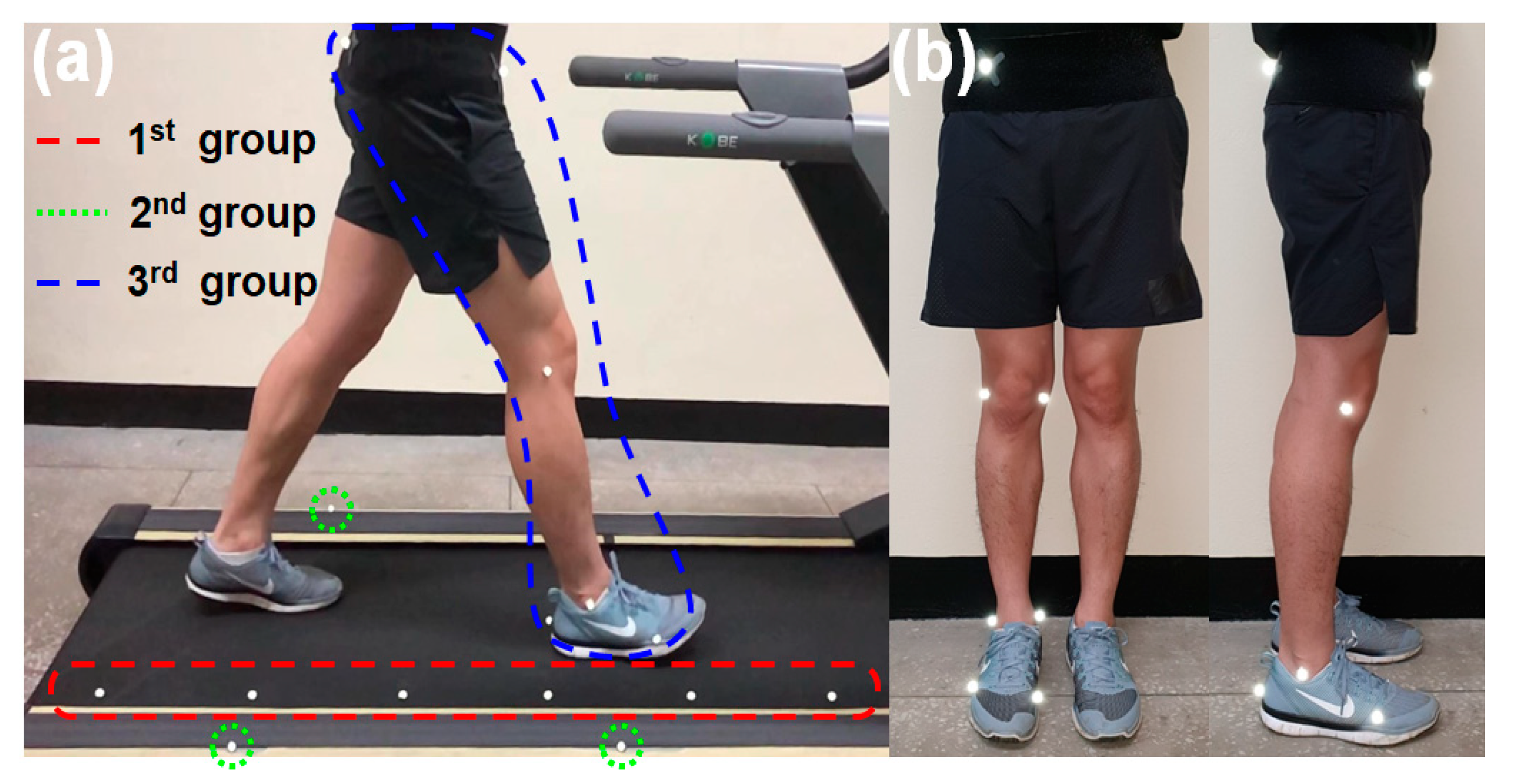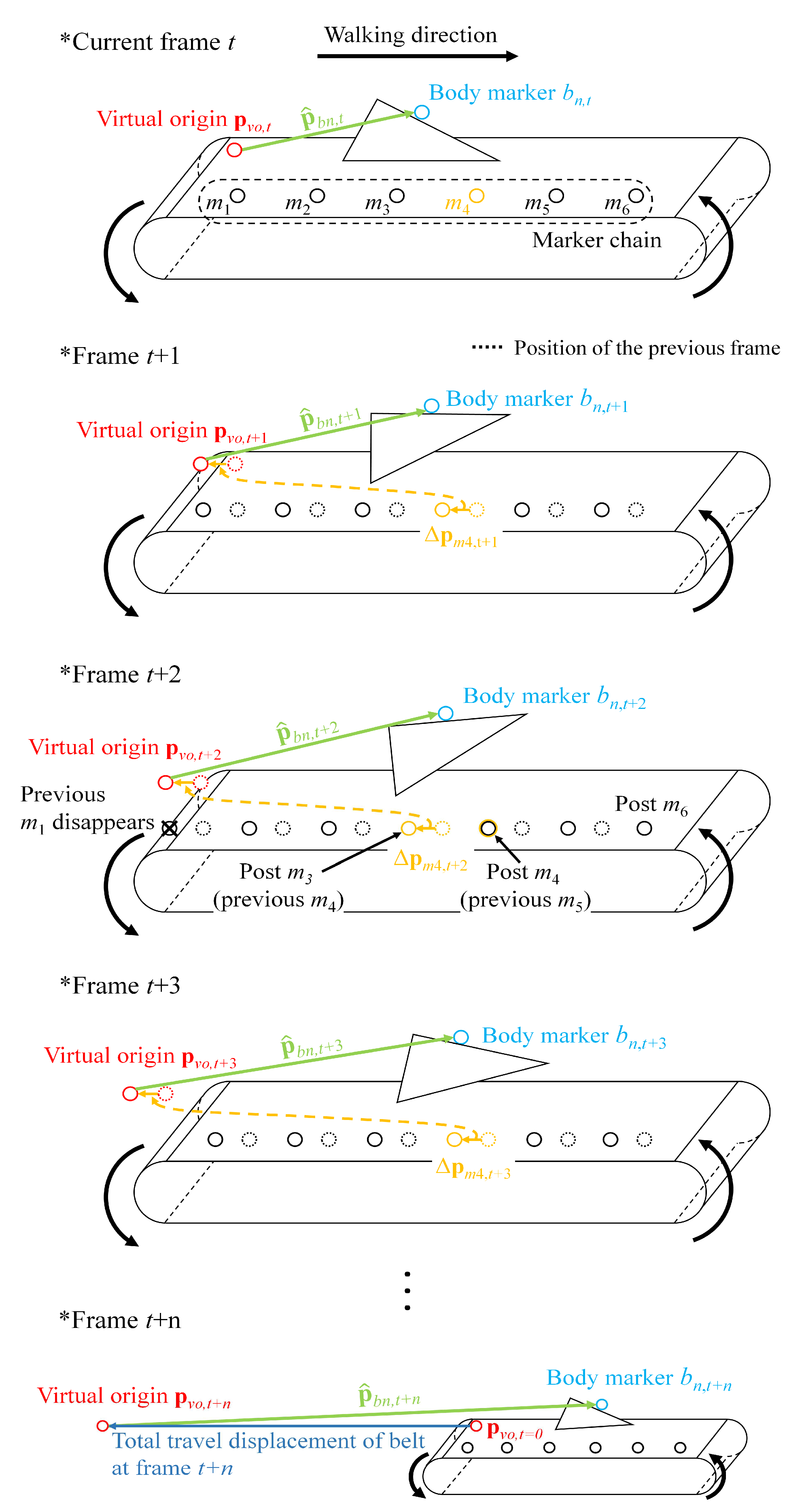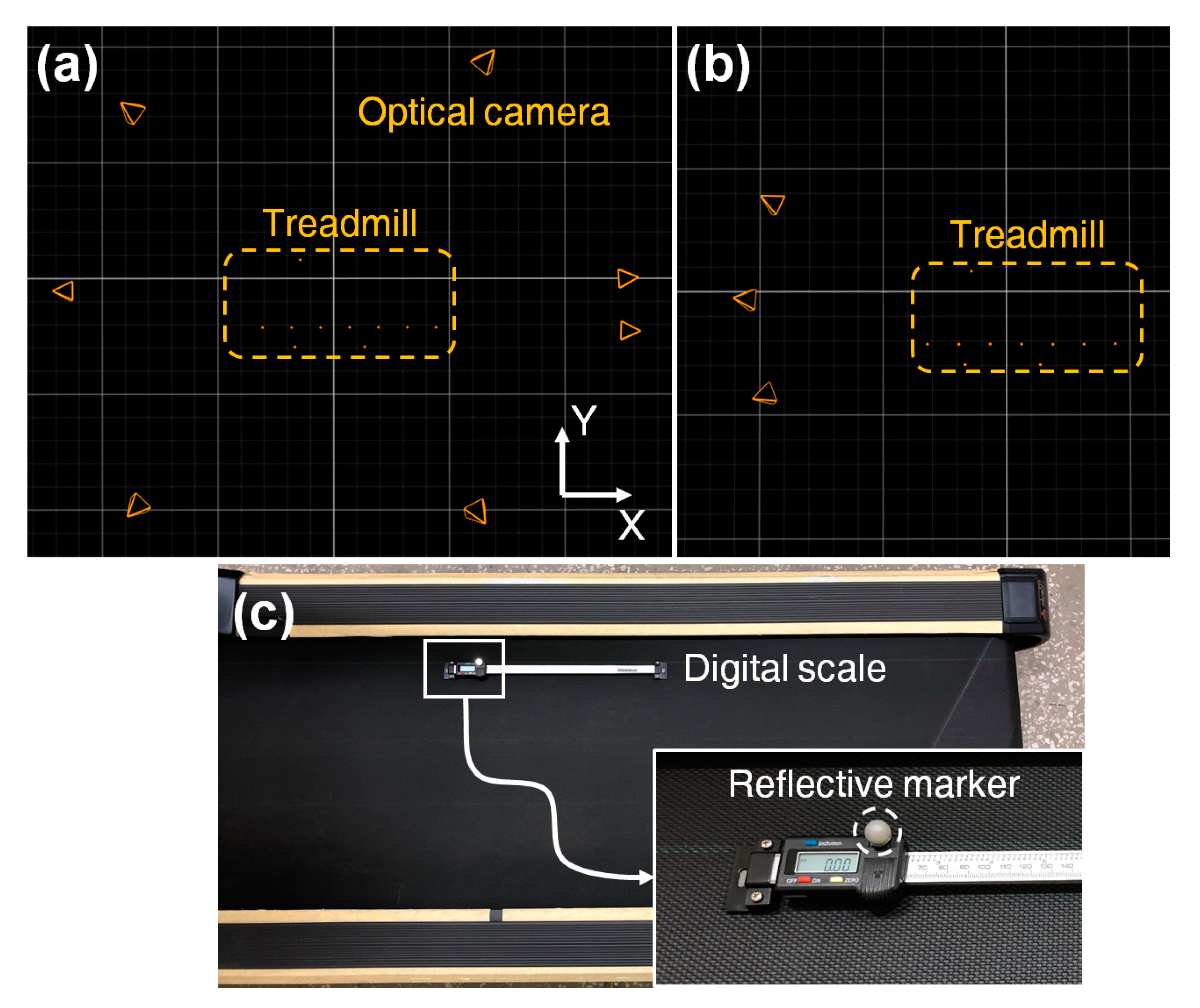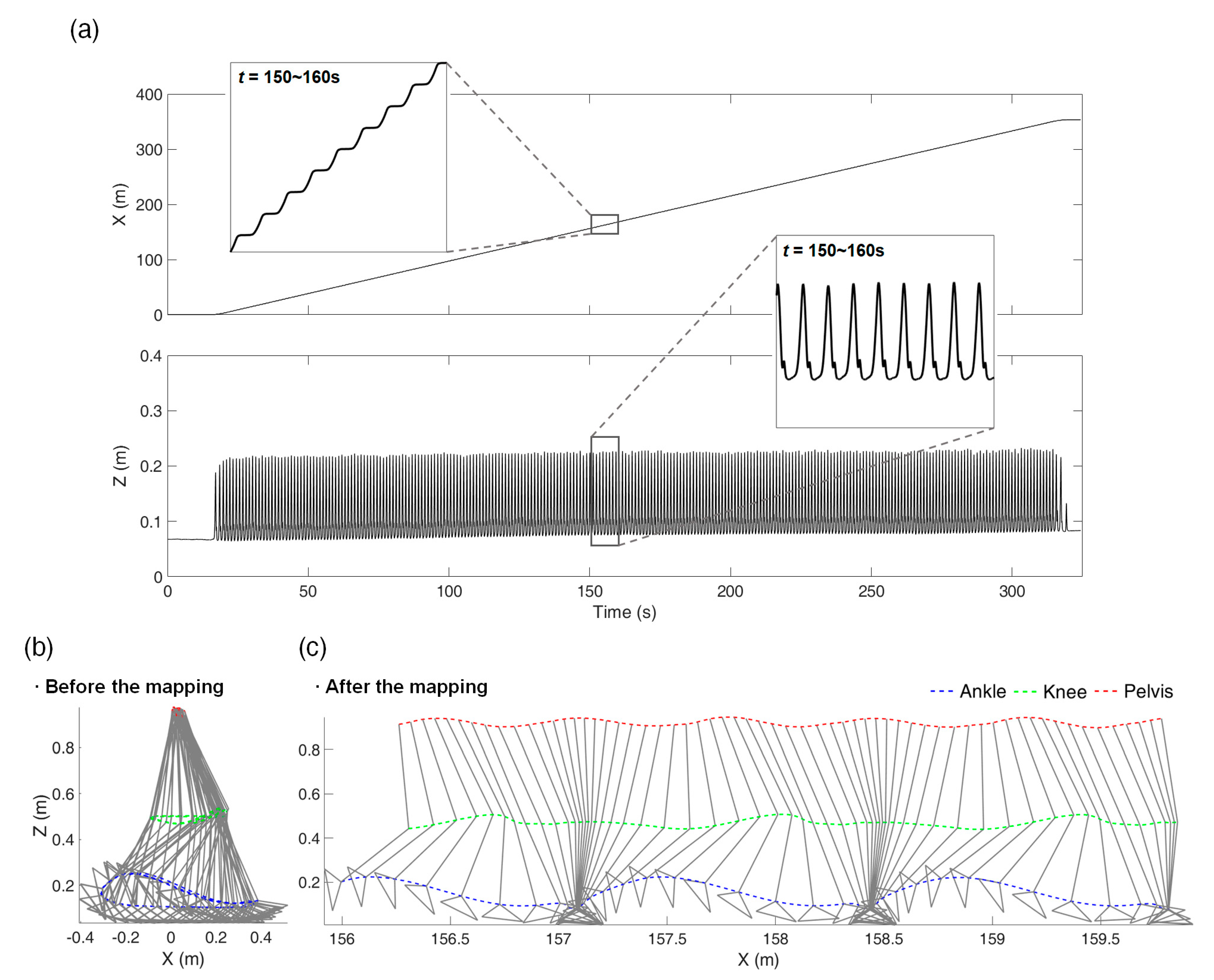Treadmill-to-Overground Mapping of Marker Trajectory for Treadmill-Based Continuous Gait Analysis
Abstract
1. Introduction
2. Method and Experiments
2.1. Treadmill-to-Overground Mapping Method
2.2. Experiments
2.2.1. Test without Pedestrian Walking
2.2.2. Test with Pedestrian Walking
3. Results
4. Discussion and Conclusions
Author Contributions
Funding
Institutional Review Board Statement
Informed Consent Statement
Data Availability Statement
Conflicts of Interest
References
- Tudor-Locke, C.; Johnson, W.D.; Katzmarzyk, P.T. Accelerometer-Determined Steps per Day inUS Adults. Med. Sci. Sports Exerc. 2009, 41, 1384–1391. [Google Scholar] [CrossRef]
- Rucco, R.; Agosti, V.; Jacini, F.; Sorrentino, P.; Varriale, P.; De Stefano, M.; Milan, G.; Montella, P.; Sorrentino, G. Spa-tio-temporal and kinematic gait analysis in patients with Frontotemporal dementia and Alzheimer’s disease through 3D motion capture. Gait Posture 2017, 52, 312–317. [Google Scholar] [CrossRef]
- Eichelberger, P.; Ferraro, M.; Minder, U.; Denton, T.; Blasimann, A.; Krause, F.; Baur, H. Analysis of accuracy in optical mo-tion capture—A protocol for laboratory setup evaluation. J. Biomech. 2016, 49, 2085–2088. [Google Scholar] [CrossRef] [PubMed]
- Van Der Krogt, M.M.; Sloot, L.H.; Harlaar, J. Overground versus self-paced treadmill walking in a virtual environment in children with cerebral palsy. Gait Posture 2014, 40, 587–593. [Google Scholar] [CrossRef]
- Robert-Lachaine, X.; Parent, G.; Fuentes, A.; Hagemeister, N.; Aissaoui, R. Inertial motion capture validation of 3D knee kinematics at various gait speed on the treadmill with a double-pose calibration. Gait Posture 2020, 77, 132–137. [Google Scholar] [CrossRef] [PubMed]
- Yeo, S.S.; Park, G.Y. Accuracy Verification of Spatio-Temporal and Kinematic Parameters for Gait Using Inertial Measurement Unit System. Sensors 2020, 20, 1343. [Google Scholar] [CrossRef] [PubMed]
- Demura, T.; Demura, S.-I.; Yamaji, S.; Yamada, T.; Kitabayashi, T. Gait characteristics when walking with rounded soft sole shoes. Foot 2012, 22, 18–23. [Google Scholar] [CrossRef] [PubMed]
- Marín, J.; Blanco, T.; Marín, J.J.; Moreno, A.; Martitegui, E.; Aragüés, J.C. Integrating a gait analysis test in hospital rehabili-tation: A service design approach. PLoS ONE 2019, 14, e0224409. [Google Scholar] [CrossRef]
- Niswander, W.; Wang, W.; Kontson, K. Optimization of IMU Sensor Placement for the Measurement of Lower Limb Joint Kinematics. Sensors 2020, 20, 5993. [Google Scholar] [CrossRef]
- Marín, J.; Blanco, T.; de la Torre, J.; Marín, J.J. Gait analysis in a box: A system based on magnetometer-free IMUs or clusters of optical markers with automatic event detection. Sensors 2020, 20, 3338. [Google Scholar] [CrossRef]
- Thewlis, D.; Bishop, C.; Daniell, N.; Paul, G. Next generation low-cost motion capture systems can provide comparable spa-tial accuracy to high-end Systems. J. Appl. Biomech. 2013, 29, 112–117. [Google Scholar] [CrossRef] [PubMed]
- Leboeuf, F.; Baker, R.; Barré, A.; Reay, J.; Jones, R.; Sangeux, M. The conventional gait model, an open-source implementa-tion that reproduces the past but prepares for the future. Gait Posture 2019, 69, 235–241. [Google Scholar] [CrossRef]
- Gholami, M.; Napier, P.C.; Menon, C. Estimating Lower Extremity Running Gait Kinematics with a Single Accelerometer: A Deep Learning Approach. Sensors 2020, 20, 2939. [Google Scholar] [CrossRef] [PubMed]
- Sabatini, A.M.; Martelloni, C.; Scapellato, S.; Cavallo, F. Assessment of Walking Features from Foot Inertial Sensing. IEEE Trans. Biomed. Eng. 2005, 52, 486–494. [Google Scholar] [CrossRef] [PubMed]
- Sibley, K.M.; Tang, A.; Patterson, K.K.; Brooks, D.; McIlroy, W.E. Changes in spatiotemporal gait variables over time dur-ing a test of functional capacity after stroke. J. NeuroEng. Rehabil. 2009, 6, 27. [Google Scholar] [CrossRef] [PubMed]
- Iosa, M.; Morone, G.; Fusco, A.; Pratesi, L.; Bragoni, M.; Coiro, P.; Multari, M.; Venturiero, V.; De Angelis, D.; Paolucci, S. Ef-fects of walking endurance reduction on gait stability in patients with stroke. Stroke Res. Treat. 2012, 2012, 81015. [Google Scholar]
- Nüesch, C.; Roos, E.; Pagenstert, G.; Mündermann, A. Measuring joint kinematics of treadmill walking and running: Com-parison between an inertial sensor based system and a camera-based system. J. Biomech. 2017, 57, 32–38. [Google Scholar] [CrossRef]
- Sinitski, E.H.; Lemaire, E.D.; Baddour, N.; Besemann, M.; Dudek, N.L.; Hebert, J.S. Fixed and self-paced treadmill walking for able-bodied and transtibial amputees in a multi-terrain virtual environment. Gait Posture 2015, 41, 568–573. [Google Scholar] [CrossRef]
- Kimel-Naor, S.; Gottlieb, A.; Plotnik, M. The effect of uphill and downhill walking on gait parameters: A self-paced tread-mill study. J. Biomech. 2017, 60, 142–149. [Google Scholar] [CrossRef]
- Hutchinson, L.A.; De Asha, A.R.; Rainbow, M.J.; Dickinson, A.W.; Deluzio, K.J. A comparison of centre of pressure behav-iour and ground reaction force magnitudes when individuals walk overground and on an instrumented treadmill. Gait Posture 2020, 83, 174–176. [Google Scholar] [CrossRef]
- Lee, J.K.; Park, E.J. Quasi real-time gait event detection using shank-attached gyroscopes. Med Biol. Eng. Comput. 2011, 49, 707–712. [Google Scholar] [CrossRef] [PubMed]
- Friedman, J.; Friedman, H. Fatigue in Parkinson’s disease. Neurology 1993, 43, 2016. [Google Scholar] [CrossRef] [PubMed]
- Sehle, A.; Mu¨ndermann, A.; Starrost, K.; Sailer, S.; Becher, I.; Dettmers, C.; Vieten, M.M. Objective assessment of motor fatigue in multiple sclerosis using kinematic gait analysis: A pilot study. J. Neuroeng. Rehabilitation 2011, 8, 59. [Google Scholar] [CrossRef] [PubMed]
- Kelleher, K.J.; Spence, W.; Solomonidis, S.; Apatsidis, D. The characterisation of gait patterns of people with multiple scle-rosis. Disabil. Rehabil. 2010, 32, 1242–1250. [Google Scholar] [CrossRef] [PubMed]
- Seel, T.; Raisch, J.; Schauer, T. IMU-Based Joint Angle Measurement for Gait Analysis. Sensors 2014, 14, 6891–6909. [Google Scholar] [CrossRef]
- Ferrari, A.; Ginis, P.; Hardegger, M.; Casamassima, F.; Rocchi, L.; Chiari, L. A Mobile Kalman-Filter Based Solution for the Real-Time Estimation of Spatio-Temporal_newline Gait Parameters. IEEE Trans. Neural Syst. Rehabilitation Eng. 2016, 24, 764–773. [Google Scholar] [CrossRef]
- Van Hamme, T.; Garofalo, G.; Rúa, E.A.; Preuveneers, D.; Joosen, W. A Systematic Comparison of Age and Gender Prediction on IMU Sensor-Based Gait Traces. Sensors 2019, 19, 2945. [Google Scholar] [CrossRef]
- Fusca, M.; Negrini, F.; Perego, P.; Magoni, L.; Molteni, F.; Andreoni, G. Validation of a wearable IMU system for gait analy-sis: Protocol and application to a new system. Appl. Sci. 2018, 8, 1167. [Google Scholar] [CrossRef]
- Teufl, W.; Lorenz, M.; Miezal, M.; Taetz, B.; Fröhlich, M.; Bleser, G. Towards Inertial Sensor Based Mobile Gait Analysis: Event-Detection and Spatio-Temporal Parameters. Sensors 2018, 19, 38. [Google Scholar] [CrossRef]
- Han, S.H.; Kim, C.O.; Kim, K.J.; Jeon, J.; Hsienhao, C.; Kim, E.S.; Park, H. Quantitative analysis of the bilateral coordination and gait asymmetry using inertial measurement unit-based gait analysis. PLoS ONE 2019, 14, e0222913. [Google Scholar] [CrossRef]
- Dehzangi, O.; Taherisadr, M.; ChangalVala, R. IMU-based gait recognition using convolutional neural networks and mul-ti-sensor fusion. Sensors 2017, 17, 2735. [Google Scholar] [CrossRef] [PubMed]
- Bastas, G.; Fleck, J.J.; Peters, R.A.; Zelik, K.E. IMU-based gait analysis in lower limb prosthesis users: Comparison of step demarcation algorithms. Gait Posture 2018, 64, 30–37. [Google Scholar] [CrossRef] [PubMed]
- Tunca, C.; Pehlivan, N.; Ak, N.; Arnrich, B.; Salur, G.; Ersoy, C. Inertial Sensor-Based Robust Gait Analysis in Non-Hospital Settings for Neurological Disorders. Sensors 2017, 17, 825. [Google Scholar] [CrossRef]
- Lee, J.K.; Park, E.J. Minimum-Order Kalman Filter With Vector Selector for Accurate Estimation of Human Body Orientation. IEEE Trans. Robot. 2009, 25, 1196–1201. [Google Scholar] [CrossRef]
- Lee, J.K. A Parallel Attitude-Heading Kalman Filter Without State-Augmentation of Model-Based Disturbance Components. IEEE Trans. Instrum. Meas. 2019, 68, 2668–2670. [Google Scholar] [CrossRef]
- Bonato, P. Wearable sensors and systems—From enabling technology to clinical applications. IEEE Eng. Med. Biol. Mag. 2010, 29, 25–36. [Google Scholar] [CrossRef]
- Coviello, G.; Avitabile, G.; Florio, A. A synchronized multi-unit wireless platform for long-term activity monitor-ing. Electronics 2020, 9, 1118. [Google Scholar] [CrossRef]
- Oniga, S.; Tisan, A.; Bólyi, R. Activity and health status monitoring system. In Proceedings of the 2017 IEEE 26th International Symposium on Industrial Electronics (ISIE), Edinburgh, UK, 8 August 2017; pp. 2027–2031. [Google Scholar]
- Michalos, G.; Makris, S.; Tsarouchi, P.; Guasch, T.; Kontovrakis, D.; Chryssolouris, G. Design considerations for safe hu-man-robot collaborative workplaces. Procedia CIRP 2015, 37, 248–253. [Google Scholar] [CrossRef]
- Roy, S.; Edan, Y. Investigating Joint-Action in Short-Cycle Repetitive Handover Tasks: The Role of Giver Versus Receiver and its Implications for Human-Robot Collaborative System Design. Int. J. Soc. Robot. 2020, 12, 973–988. [Google Scholar] [CrossRef]
- Tsarouchi, P.; Matthaiakis, A.-S.; Makris, S.; Chryssolouris, G. On a human-robot collaboration in an assembly cell. Int. J. Comput. Integr. Manuf. 2016, 30, 580–589. [Google Scholar] [CrossRef]
- Tsarouchi, P.; Michalos, G.; Makris, S.; Athanasatos, T.; Dimoulas, K.; Chryssolouris, G. On a human–robot workplace de-sign and task allocation system. Int. J. Comput. Integr. Manuf. 2017, 30, 1272–1279. [Google Scholar] [CrossRef]
- Someshwar, R.; Edan, Y. Givers & receivers perceive handover tasks differently: Implications for human-robot collabora-tive system design. arXiv 2017, arXiv:1708.06207. [Google Scholar]
- Michalos, G.; Makris, S.; Spiliotopoulos, J.; Misios, I.; Tsarouchi, P.; Chryssolouris, G. ROBO-PARTNER: Seamless hu-man-robot cooperation for intelligent flexible and safe operations in the assembly factories of the future. Procedia CIRP 2014, 23, 71–76. [Google Scholar] [CrossRef]






| Speed | Reference | Error | Error Rate |
|---|---|---|---|
| (a) Camera setting 1 | |||
| 2 km/h | 18,080.3 cm | 36.2 ± 0.5 cm | 0.20 ± 0.003% |
| 4 km/h | 36,239.7 cm | 66.0 ± 0.3 cm | 0.18 ± 0.001% |
| 6 km/h | 54,412.0 cm | 101.2 ± 0.5 cm | 0.19 ± 0.001% |
| (b) Camera setting 2 | |||
| 2 km/h | 18,080.0 cm | 183.2 ± 1.0 cm | 1.01 ± 0.005% |
| 4 km/h | 36,238.1 cm | 365.2 ± 1.47 cm | 1.01 ± 0.004% |
| 6 km/h | 54,417.9 cm | 542.1 ± 2.47 cm | 1.00 ± 0.005% |
| (a) Constant-speed walking without inclination | ||||
| Trial 1 | Trial 2 | Trial 3 | Average | |
| Reference | 35,198.7 | 35,177.7 | 35,179.6 | - |
| Proposed | 35,311.4 | 35,287.5 | 35,293.0 | - |
| Error | 112.7 | 109.8 | 113.4 | 111.9 |
| Error rate | 0.32% | 0.31% | 0.32% | 0.32% |
| (b) Variable-speed walking with various inclinations | ||||
| Trial 4 | Trial 5 | Trial 6 | Average | |
| Reference | 54,596.4 | 54,582.1 | 54,548.0 | - |
| Proposed | 54,763.4 | 54,749.8 | 54,715.2 | - |
| Error | 169.8 | 167.0 | 167.7 | 167.3 |
| Error rate | 0.31% | 0.31% | 0.31% | 0.31% |
Publisher’s Note: MDPI stays neutral with regard to jurisdictional claims in published maps and institutional affiliations. |
© 2021 by the authors. Licensee MDPI, Basel, Switzerland. This article is an open access article distributed under the terms and conditions of the Creative Commons Attribution (CC BY) license (http://creativecommons.org/licenses/by/4.0/).
Share and Cite
Jung, W.C.; Lee, J.K. Treadmill-to-Overground Mapping of Marker Trajectory for Treadmill-Based Continuous Gait Analysis. Sensors 2021, 21, 786. https://doi.org/10.3390/s21030786
Jung WC, Lee JK. Treadmill-to-Overground Mapping of Marker Trajectory for Treadmill-Based Continuous Gait Analysis. Sensors. 2021; 21(3):786. https://doi.org/10.3390/s21030786
Chicago/Turabian StyleJung, Woo Chang, and Jung Keun Lee. 2021. "Treadmill-to-Overground Mapping of Marker Trajectory for Treadmill-Based Continuous Gait Analysis" Sensors 21, no. 3: 786. https://doi.org/10.3390/s21030786
APA StyleJung, W. C., & Lee, J. K. (2021). Treadmill-to-Overground Mapping of Marker Trajectory for Treadmill-Based Continuous Gait Analysis. Sensors, 21(3), 786. https://doi.org/10.3390/s21030786






